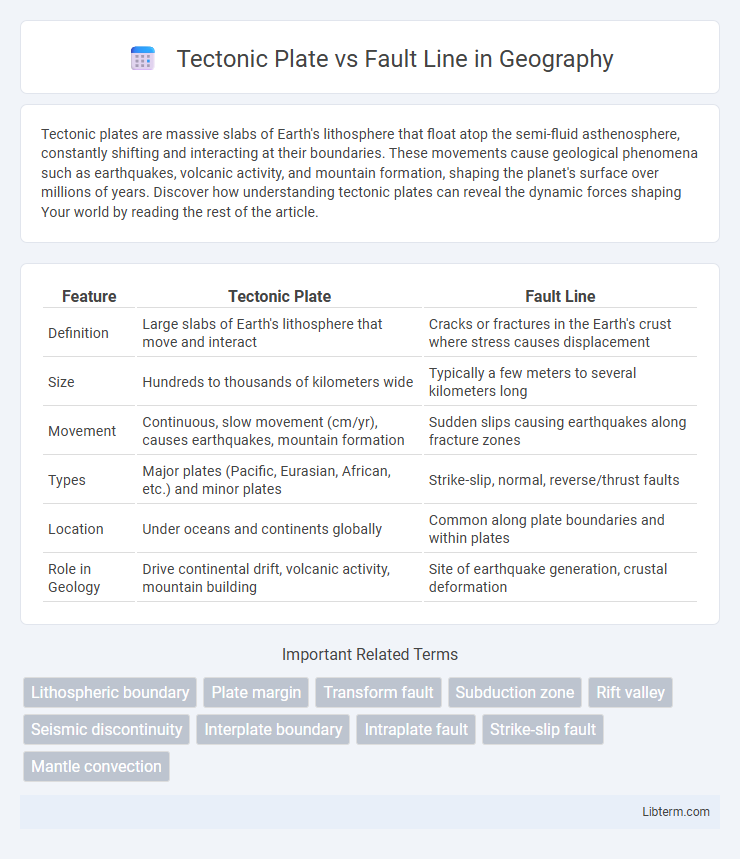Tectonic plates are massive slabs of Earth's lithosphere that float atop the semi-fluid asthenosphere, constantly shifting and interacting at their boundaries. These movements cause geological phenomena such as earthquakes, volcanic activity, and mountain formation, shaping the planet's surface over millions of years. Discover how understanding tectonic plates can reveal the dynamic forces shaping Your world by reading the rest of the article.
Table of Comparison
| Feature | Tectonic Plate | Fault Line |
|---|---|---|
| Definition | Large slabs of Earth's lithosphere that move and interact | Cracks or fractures in the Earth's crust where stress causes displacement |
| Size | Hundreds to thousands of kilometers wide | Typically a few meters to several kilometers long |
| Movement | Continuous, slow movement (cm/yr), causes earthquakes, mountain formation | Sudden slips causing earthquakes along fracture zones |
| Types | Major plates (Pacific, Eurasian, African, etc.) and minor plates | Strike-slip, normal, reverse/thrust faults |
| Location | Under oceans and continents globally | Common along plate boundaries and within plates |
| Role in Geology | Drive continental drift, volcanic activity, mountain building | Site of earthquake generation, crustal deformation |
Understanding Tectonic Plates
Tectonic plates are massive slabs of Earth's lithosphere that float on the semi-fluid asthenosphere beneath, driving the planet's geological activity. These plates interact at boundaries, where they can diverge, converge, or slide past each other, causing significant seismic events such as earthquakes. Fault lines are fractures within these plates or at their boundaries where the movement occurs, serving as indicators of plate interactions and potential zones of seismic hazard.
What are Fault Lines?
Fault lines are fractures in the Earth's crust where tectonic plates meet or slide past each other, causing stress accumulation and release in the form of earthquakes. These zones of weakness often mark boundaries between major tectonic plates, such as the San Andreas Fault in California. Understanding fault lines is crucial for assessing seismic risk and predicting earthquake activity in vulnerable regions.
Key Differences Between Tectonic Plates and Fault Lines
Tectonic plates are massive slabs of Earth's lithosphere that move and interact at their boundaries, driving seismic activity and continental drift. Fault lines are fractures or zones of weakness within these plates where intense stress causes rocks to slip, often triggering earthquakes. The primary difference lies in scale and function: tectonic plates are large, rigid sections shaping Earth's surface, while fault lines are localized fractures where movement and seismic events occur.
How Tectonic Plates Move
Tectonic plates move due to convection currents in the Earth's mantle, causing them to drift, collide, or slide past each other at varying speeds. This movement results in the formation of fault lines, where stress accumulates and eventually causes earthquakes. Understanding the dynamics of plate tectonics is crucial for predicting seismic activity along fault zones.
Types of Fault Lines
Fault lines are fractures in the Earth's crust where tectonic plates meet and move, with the main types being strike-slip, normal, and reverse faults. Strike-slip faults involve horizontal movement, typical along transform plate boundaries like the San Andreas Fault. Normal faults occur where plates diverge, causing the crust to extend, while reverse faults form under compressional forces where plates converge, resulting in crustal shortening.
The Role of Plate Boundaries
Tectonic plate boundaries are the primary zones where tectonic plates interact, leading to the formation of fault lines due to the stress and movement between plates. Divergent, convergent, and transform boundaries each create distinct fault lines that influence seismic activity and geological formations. Understanding plate boundaries is essential for predicting earthquake behavior and the development of mountain ranges, trenches, and rift valleys.
Earthquake Triggers: Plates vs Faults
Tectonic plates are massive sections of Earth's lithosphere whose movements generate significant stress along plate boundaries, acting as primary earthquake triggers. Fault lines are fractures within these plates where accumulated stress is released through sudden slips, causing earthquakes. While plate movements create broader regional stress, fault lines localize and focus seismic energy, making faults the direct trigger of most earthquakes.
Mapping Tectonic Plates and Fault Lines
Mapping tectonic plates involves identifying the large sections of the Earth's lithosphere that move and interact at their boundaries, while fault lines are fractures within these plates where earthquakes commonly occur. High-resolution satellite imagery and seismic data are critical in delineating the precise locations of tectonic plate boundaries and associated fault lines. Advanced geospatial technologies such as GPS and LiDAR enable detailed mapping of fault line movements, enhancing the understanding of seismic risks and plate tectonics dynamics.
Real-World Examples of Plates and Faults
The Pacific Plate is one of the largest tectonic plates, moving northwestward and interacting with surrounding plates along the famous San Andreas Fault in California, a major transform fault responsible for significant seismic activity. Another critical example is the collision between the Indian Plate and the Eurasian Plate, forming the Himalayan mountain range and the extensive Main Himalayan Thrust fault system. The East African Rift, a divergent tectonic boundary splitting the African Plate into smaller plates, showcases active fault lines such as the Eastern Rift faults driving continental breakup.
Importance in Geology and Earthquake Preparedness
Tectonic plates are massive sections of Earth's lithosphere whose interactions generate significant geological activity, including earthquakes, making their study vital in geology. Fault lines represent fractures where these plates or crustal blocks slide past each other, directly indicating zones of seismic risk. Understanding the dynamics between tectonic plates and fault lines enhances earthquake preparedness by informing hazard assessments and guiding construction codes to mitigate potential damage.
Tectonic Plate Infographic

 libterm.com
libterm.com